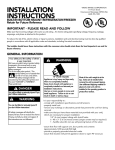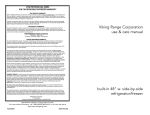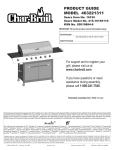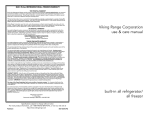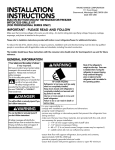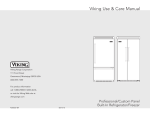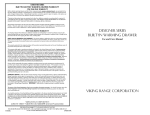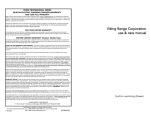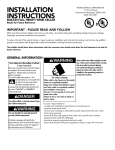Download Viking VCSB423 Specifications
Transcript
INSTALLATION INSTRUCTIONS BUILT-IN SIDE-BY-SIDE REFRIGERATOR/FREEZER VIKING RANGE CORPORATION 111 Front Street Greenwood, Mississippi (MS) 38930 USA (662) 455-1200 (VCSB423 Professional Model) IMPORTANT - PLEASE READ AND FOLLOW Make sure that incoming voltage is the same as unit rating. An electric rating plate specifying voltage, frequency, wattage, amperage, and phase is attached to the product. To reduce the risk of fire, electric shock, or injury to persons, installation work and electrical wiring must be done by qualified people in accordance with all applicable codes and standards, including fire-rated construction. The installer should leave these instructions with the consumer who should retain them for local inspector’s use and for future reference. GENERAL INFORMATION Your safety and the safety of others is very important. We have provided many important safety messages in this manual and on your appliance. Always read and obey all safety messages. This is the safety alert symbol. This symbol alerts you to hazards that can kill or hurt you and others. All safety messages will be preceded by the safety alert symbol and the word “DANGER” or “WARNING”. These words mean: You will be killed or seriously injured if you don’t follow instructions. You can be killed or seriously injured if you don’t follow instructions. All safety messages will identify the hazard, tell you how to reduce the chance if injury, and tell you what can happen if the instructions are not followed. TIP OVER HAZARD Refrigerator is top heavy and tips easily when not completely installed. Keep doors closed until refrigerator is completely installed and secured per installation instructions. Use two or more people to move and install refrigerator. Failure to do so can result in death or serious injury. Most of the refrigerator’s weight is at the top. Extra care is needed when moving the refrigerator to prevent tipping. Use cardboard shipping material or plywood under refrigerator until it is installed in the operating position to protect floor surface. It is your responsibility to : -comply with installation specifications and dimensions -properly install refrigerator -remove any moldings or decorative panels that prevent the refrigerator from being serviced -make sure that you have these materials (not provided with your refrigerator), which are necessary for proper installation: 1/4” (6 mm) copper tubing with shutoff valve 6 - #8 x 3” (7.6 cm) wood screws (Longer screws may be required.) 1 - Saddle valve (Do not use self-piercing feature of the valve) -assure that floor will support refrigerator, door panels and contents (approximately 1200 pounds [540 kg]) -provide a properly grounded electrical outlet -assure that location will permit appliance doors to open 90o minimum FEATURES OF YOUR REFRIGERATOR (NON-DISPENSER MODEL) 1. Electronic controls 2. Dairy compartments (2) 3. Adjustable door bins (4) 4. Meat SavorTM/Produce Drawer (1) 5. Moisture-controlled produce drawer (1) 6. Spillproof shelves (5) 7. 8. 9. 10. 11. 12. Non-adjusting freezer shelf (1) Ice bucket (1) Adjustable freezer shelves (3) Adjustable freezer door bins (4) Glide-out freezer baskets (2) Lights 1 10 12 9 2 7 3 12 11 8 6 4 5 2 SITE PREPARATIONS AND CONSIDERATIONS PROFESSIONAL MODEL 42” W. SIDE-BY-SIDE CABINET OPENING DIMENSIONS (2) 2”x4” Mounting boards (1 1/2” (3.8 cm) x 3 1/2” (8.9 cm) Note: If unit is installed deeper than 24” (61.0 cm), then increase the mounting boards by the same amount 3 WATER SUPPLY REQUIREMENTS ELECTRICAL SHOCK HAZARD Some water may remain in line. Electric drill must be grounded to prevent severe or lethal shock if water is in line and enters drill during use. Use only 1/4” (6 mm) copper tubing for water line. Do Not install copper tubing in area where temperatures drop below 35oF (1.7oC). Before attaching copper tubing to refrigerator, flush at least 2 quarts (1.9 L) of water through the copper tubing and into a bucket to remove any particles in the water line. •Viking Range Corporation is not responsible for property damage due to improper installation or water connection. •Connect 1/4” (6mm) flexible copper tubing to household plumbing in compliance with local codes and ordinances. •Length of copper tubing must reach from water supply connection to refrigerator connection with an additional length to facilitate moving the refrigerator out of enclosure for cleaning or service. Tubing should be soft instead of rigid and ends should be free of burrs. •Copper tubing route must be above 35oF (1.6oC) to prevent water line from freezing. •Do not use plastic water lines. •Do not use the self-piercing feature of a saddle valve. The hole made by the piercing lance is too small for the water flow rate required by the ice maker. To use a saddle valve, follow the instructions below located under “To rough in water line” on how to pre-drill a 3/16” diameter hole. •If saddle valve is not used, place a separate shut-off valve in an easily accessible location between water supply and refrigerator. Do not locate shut-off valve behind refrigerator. Do not use with reverse osmosis water filtration system. This will void warranty. •D •Connect a vertical or horizontal 1/2” (1.2 cm) to 1 1/4” (3.2 cm) COLD water line near refrigerator area. •Run water line through the floor, back, or side wall. Tubing should lay flat on floor underneath refrigerator. Clamp tubing to wall or floor. •Water pressure must be greater than 20 psi and less than 120 psi. Plumbing Dimensions *Note: Must be under 1” (2.5 cm) from back wall. *1” (2.5 cm) 41 1/2” (105.4 cm) WIDE OPENING NON-DISPENSER MODEL To rough in water line: 1. Turn OFF main water supply. Turn ON nearest faucet long enough to clear line of water. 2. Vertical cold water line: Use grounded electric drill or hand drill to drill 3/16” (4.5 mm) hole in an easily accessible location in water line. Horizontal cold water line: Use grounded electric drill or hand drill to drill 3/16” (4.5 mm) hole in the TOP of the water line. This will keep sediment from collecting in valve. 3. Position washer over hole in water line. Turn saddle valve handle clockwise to expose piercing lance a maximum of 3/16” (4.5 mm). Align piercing lance over hole in water line. Place both halves of saddle valve bracket against water line. Turn saddle valve handle clockwise until piercing lance enters hole in water line and is firmly seated. The saddle valve is now in the closed position. Tighten packing nut. Evenly and firmly tighten bracket screws so washer will make a water-tight connection. Do not overtighten screws: copper tubing could be crushed. 4 WATER SUPPLY REQUIREMENTS (con’t) 4. Check that both ends of copper tubing are cut square. Slide compression nut and sleeve onto copper tubing. Insert end of copper tubing completely into valve outlet. Tighten compression nut to outlet with adjustable wrench. Do not overtighten. 5. Turn on main water supply. Check for leaks. Turn saddle valve handle counterclockwise and run 2 quarts of water through copper tubing and into a bucket. Turn saddle valve clockwise to shut off water to copper tubing. 6. Route copper tubing to refrigerator area. 7. Leave an additional length of copper tubing coil to facilitate moving the refrigerator out of enclosure for cleaning or service. 8. See page 13 for water connection instructions. AREA REQUIREMENTS Verify the following: •Refrigerator can fit into residence and can be moved around corners and through doorways. •Floors can support refrigerator’s weight plus food weight (approximately 1200 pounds total). •Rear wall is solid and is able to support two (2) horizontally mounted 2X4s (included) bolted to 2 wall studs. The 2X4 board bolt heads must be flush with 2X4 to prevent obstruction. •Remove anything attached to rear or side walls that can obstruct refrigerator installation. •Cutout dimensions are accurate. •Electrical outlet is in correct location. •Water line is in correct location. ELECTRICAL REQUIREMENTS ELECTRICAL SHOCK HAZARD Plug into a grounded 3-prong outlet. DO NOT remove ground plug. DO NOT use an adapter. DO NOT use an extension cord. Failure to follow these instructions could result in fire or electrical shock. If codes permit a separate grounding wire to be used, it is recommended that a qualified electrician determine that the grounding path is adequate. Do Not ground to a gas pipe. Check with a qualified electrician if you are not sure the appliance is properly grounded. Do Not have a fuse in the neutral or grounding circuit. It is the customer’s responsibility to: •contact a qualified electrical installer. •assure that the electrical installation is adequate and in conformance with the National Electrical Code, ANSI/NFPA 70-latest edition or Canadian Electrical Code C22.1-1998 and C22.2 No. 0-M91 (or latest edition), and all local codes and ordinances. (115 volt, 60-Hz, 15 amp, fused, electrical supply is required. It is required that a separate circuit serving only this appliance be provided. This appliance is equipped with a power supply cord having a 3prong grounding plug. To minimize possible shock hazard, the cord must be plugged into a mating 3-prong, grounding-type wall receptacle. Do not use an extension cord.) 5 Anti-Tip Requirements TIP OVER HAZARD Refrigerator is top heavy and tips easily when not completely installed. Keep doors closed until refrigerator is completely installed and secured per installation instructions. Use two or more people to move and install refrigerator. Failure to do so can result in death or serious injury. The anti-tip boards should be fastened into position prior to moving the unit into the opening. Note: Additional mounting boards may be required if the refrigerator does not touch the back wall of the enclosure. To prevent refrigerator from tipping forward, it must be secured in place with a solid soffit or wood block. DOOR SWING AND TIPPING CONSIDERATIONS 42” (106.7 cm) 10 1/32” (26.3 cm) 12 21/32” (32.1 cm) 41” (104.1 cm) 8 1/8” (20.6 cm) 24 23/32” (62.8 cm) 41 5/16” (104.9 cm) 9 1/16” (24.6 cm) 3” (7.6 cm) 3” (7.6 cm) 45 31/32” (116.8 cm) 40 19/32” (103.1 cm) 45” (114.3 cm) 43 1/2” (110.5 cm) 39 15/32” (100.3 cm) 2 1/2” (6.4 cm) 111 1/16” (282.1 cm) 134 25/32” (342.3 cm) 24 23/32” (62.8 cm) 42” (106.7 cm) 1 1/2” (3.8 cm) 9 5/32” (23.3 cm) 3 1/2” (8.9 cm) 92 25/32” (235.7 cm) 86 1/32” (219.3 cm) 82 3/4” (210.2 cm) 82 3/4” (210.2 cm) 6 SIDE-BY-SIDE REFRIGERATOR OVERALL DIMENSIONS TOP 41 1/2” (105.4 cm) 41 1/2” (105.4 cm) S 41” (104.1 cm) 9/32” (0.7 cm) S 22 3/16” (56.4 cm) 24 3/4” (62.9 cm) 5/16” (0.8 cm) S DOOR 5/16” (0.8 cm) FRONT SIDE 42” (106.7 cm) Side Trim 1 1/2” (3.8 cm) 9 5/32” (23.3 cm) 75 15/16” (192.9 cm) 82 7/8” (210.5 cm) Min. to 83 3/4” (212.7 cm) Max. 20 3/4” (52.7 cm) 22 3/16” (56.4 cm) (To rear edge of cabinet side trim) 24 11/16” (62.7 cm) 27 1/4” (69.2 cm) 7 CABINET INFORMATION Professional models fit “semi-flush” in standard 24” (61.0 cm) deep cabinet openings. The door face protrudes 2-1/2” (6.4 cm) from the cabinet face. The handle protrudes an additional 2-1/2” (6.4 cm) into the room. 41 1/2” (105.4 cm DETAIL A-A A-A 8 CUSTOM SIDE PANEL DIMENSIONS For 3/4” (1.9 cm) Side Panels 82 7/8” (210.5 cm) to 83 3/4” (212.7 cm) DEPENDING ON HOW HIGH LEVELING FEET ARE RAISED AND CABINET ENCLOSURE HEIGHT OPTIONAL KICKPLATE NOTCH - DIMENSIONS DETERMINED BY CABINETS OPTIONAL KICKPLATE NOTCH DIMENSIONS DETERMINED BY CABINETS 9 REFRIGERATOR INSTALLATION TIP OVER HAZARD Refrigerator is top heavy and tips easily when not completely installed. Keep doors closed until refrigerator is completely installed and secured per installation instructions. Use two or more people to move and install refrigerator. Failure to do so can result in death or serious injury. Use two or more people to move and install refrigerator. Failure to follow this instruction can result in back or other injury. To avoid personal injury, wear gloves when performing any installation procedure and wear eye protection when cutting metal straps. Most of the refrigerator’s weight is at the top. Extra care is needed when moving the refrigerator to prevent tipping. Do Not remove protective film until refrigerator is in operating position. All four leveling legs must contact the floor to support and stabilize the full weight. Do not drop refrigerator. Figure 1 1. Remove exterior shipping materials prior to moving refrigerator into home. Remove top and bottom strap (see Figure 1). Figure 2 2. Remove top cap (see Figure 1). 3. Cut carton rear approximately 1/4” (.64 cm) to 1” (2.5 cm) from right corner (see Figure 2) with a utility knife extended 1/4” (.6 cm). Remove carton and exterior packaging. Save cardboard shipping material to protect floor surface when installing refrigerator. Do not remove nylon cord from power cord. Remove anti-tip board and kickplate from rear of refrigerator (see Figure 3). 4. Remove shipping brackets from skid by removing 4 bolts (2 each side) with a 1/2” socket head screwdriver (see Figure 4). •Tilting refrigerator is not required to remove shipping brackets. BACK VIEW Figure 3 Figure 4 ANTI-TIP BOARDS KICKPLATE 7/16” (1.1 cm) BOLT 5. Slip cart between refrigerator and skid. Remove refrigerator from skid. Use excess packaging to protect decorative trim. Verify that leveling legs are up (0” Figure 5 Figure 6 adjustment) (see PROTECT TRIM FROM Figure 5). STRAPPING 6. To avoid floor damage, use protective material (see Figure 6). FRONT LEVELING LEGS SKID 10 PROTECT FLOOR Electrical Shock Hazard Disconnect power at breaker or turn power disconnect switch to OFF position before performing any installation procedure. Failure to do so can result in death or electrical shock. SECURING THE REFRIGERATOR (3 OPTIONS) OPTION 1 OPTION 1 If a solid soffit is 1” (2.5 cm) or less above the refrigerator, anti-tip boards are not required. OPTION 2 If a solid soffit is not available or soffit is more than 1” (2.5 cm) above refrigerator, center wood boards on rear wall 1/4” (.6 cm) maximum above refrigerator. Attach wood boards to wall studs with six of the provided wood screws, making sure that screws are engaged in wall studs 1 1/2” (3.8 cm) minimum. OPTION 3 Create “L” bracket assembly by securing “L” brackets to each end of (1) 2x4 with provided screws (Item A). If 2x4 does not extend 2” (5.0 cm) beyond rear ledge, attach (1) 2x4 to wall (Item B), attach (1) 2x4 to rear ledge of cabinet (Item C) and attach “L” bracket assembly to 2x4 mounted on wall (Item A). OPTION 2 OPTION 3 (ITEM A) (ITEM B) (ITEM C) 11 Before moving the refrigerator in place, confirm the finished dimensions, electrical location, minimum door and shelf clearances, and door panel instructions. (See pages 3, 4, & 5). 1. Position refrigerator in front of cutout. 2. Verify operation by plugging power cord in receptacle. Power switch will be shipped in the “ON” position and showroom switch will be in the “OFF” position. (If showroom switch is switched to the “ON” position, showroom mode is engaged and power is shut-off to the compressor. This mode is for showroom display only). Power Switch Showroom Switch 3. Roll refrigerator into cutout to within 3” (7.6 cm) of being flush with cabinets. To avoid kitchen cabinet damage, place cardboard between cabinets and refrigerator. Push cardboard back with refrigerator and remove cardboard when refrigerator is in place. NOTE: When moving the unit into position, be careful not to crimp, kink or crush the copper water supply line. 4. Lift the refrigerator off the rollers, adjust to desired height and level refrigerator by using a 5/16” hex head wrench. (Refer to Figure at the right) a) To raise/lower right side rear, rotate the right side rear hex rod. b) To raise/lower the left side rear, rotate the left side rear hex rod. c) To raise/lower the right side front, rotate the right side front hex rod. d) To raise/lower the left side front, rotate the left side front hex rod. NOTE: DO NOT use an electric driving device. Overtightening can cause damage. VIEW SHOWN WITH KICKPLATE REMOVED 5. Align refrigerator with sides of cabinets by adjusting leveling legs. Rotate leveling legs until firmly in place against floor. 6. To secure refrigerator, raise unit until compartment cover is firmly seated under the soffit or anti-tip boards. 7. Open door. Display should flash. Press any key. There is a 6 minute delay before the refrigerator starts. Verify the position of the power on/off and showroom switch if there is no power to refrigerator. 12 WATER CONNECTION •Refer to water supply requirement section for preliminary installation and site preparation (see page 4). •Do not use plastic water lines between refrigerator and supply. Plastic water lines can fail due to fatigue over time and cause extensive damage to product and the home. •Use only 1/4" copper tubing for water line. •Do not connect to reverse osmosis water filtration system. The 1/4" brass compression union is located in the literature packet. 1. Pull copper supply tubing from plumbing forward from underneath refrigerator (see Figure A). 2. Flush air and impurities from water line by turning on water supply and running two (2) quarts of water into a bucket. 3. Bend the open end of the supply tube to point toward the open end of the Water Valve Tube (see Figure B). Note: The Water Valve Tube is designed to flex or bend as necessary to line up with the supply tube, so union can be connected easily. 4. Remove brass nuts and ferrules from union and slide onto open ends of Water Valve Tube and supply tubing (see Figure C). 5. Connect nuts on copper tubing to union (see Figure D). Be sure both nuts are fully seated in union before tightening nuts. Do Not over tighten. 6. Turn on water supply to refrigerator and check for leaks. 7. Turn off water supply to refrigerator and correct any leaks. Repeat this process until no leaks exist. 8. Completely turn on water supply to refrigerator. 9. Verify drain pan is installed and aligned. Drain pan must be pushed past and over initial stopping point. Copper tubing Water valve tube Figure A Figure C Figure B Brass nuts and ferrules Figure D 13 KICKPLATE INSTALLATION Align the holes on both ends of the louvered panel with the holes in the base of the refrigerator. Adjust the kickplate to the desired height and fasten in place by tightening the screws in the slot. Attach the kickplate to the refrigerator on each side with the two black phillips head screws provided. Slots for adjustments (on both ends) Attach to unit with screws (on both ends) DOOR STOP ADJUSTMENT 1. Using a 3/16” allen wrench, remove door stop pin located in bottom hinge. 2. The pin is factory set 110o. For 120o swing, move the pin to the utmost forward stop hole. For 90o swing, move the pin to the utmost rear stop hole. HINGE ADJUSTMENT 1. Using a 3/16” allen wrench, remove the door stop pin located in bottom hinge. 2. Using the height adjustment shim as a wrenching device, rotate the height adjustment bushing counterclockwise to raise or clockwise to lower the location of the door. 3. When proper adjustment is reached, align shim with door stop pin holes and replace door stop pin. Firmly tighten pin in place. Door stop pin 120o position 90o position 14 BASIC SPECIFICATIONS AND DIMENSIONS DESCRIPTION VCSB423 Overall Width 42” (106.7 cm) Overall Height from Bottom Min. 82 3/4” (210.2 cm) to Max. 83 3/4” (213.0 cm) Overall Depth from Rear To rear edge of side trim To front of top grille To end of handle bracket Cutout Width 41 1/2” (105.4 cm) Cutout Height 82 7/8” (210.5 cm) min.; 83 3/4” (213.0 cm) max. Cutout Depth 24” (61.0 cm) min. Electrical Requirements 115 volt, 60 Hz, 15 amp dedicated circuit; 3-wire cord with grounded 3-prong plug attached to product. Maximum Amp Usage Inlet Water Requirements 22 3/16” (56.4 cm) 24 11/16” (62.7 cm) 27 1/4” (69.2 cm) 9.9 amps 1/4” copper tubing inlet waterline; minimum 20 psi; maximum 120 psi Overall Interior Dimensions •Refrigerator •Freezer •Total Capacity 15.0 cu. ft. ( .42 cu. meters) 9.0 cu. ft. ( .25 cu. meters) 24.0 cu. ft. ( .67 cu. meters) Approximate Shipping Weight 525 lbs. ( 236.2 kg) 15 WIRING DIAGRAM BUILT-IN SIDE-BY-SIDE 42” W. REFRIGERATOR WARNING: ELECTRICAL GROUNDING INSTRUCTIONS This appliance is equipped with a three prong grounding plug for your protection against shock hazard and should be plugged directly into a properly grounded three prong receptacle. DO NOT CUT OR REMOVE THE GROUNDING PRONG FROM THIS PLUG. REFER ONLY TO FEATURES WHICH ARE EQUIPPED WITH THIS UNIT. VIKING RANGE CORPORATION 111 Front Street • Greenwood, Mississippi (MS) 38930 USA • (662) 455-1200 Specifications subject to change without notice For more product information, call 1-888-VIKING1 (845-4641), or visit our web site at http://www.vikingrange.com F20212 (PS0403VR)


















